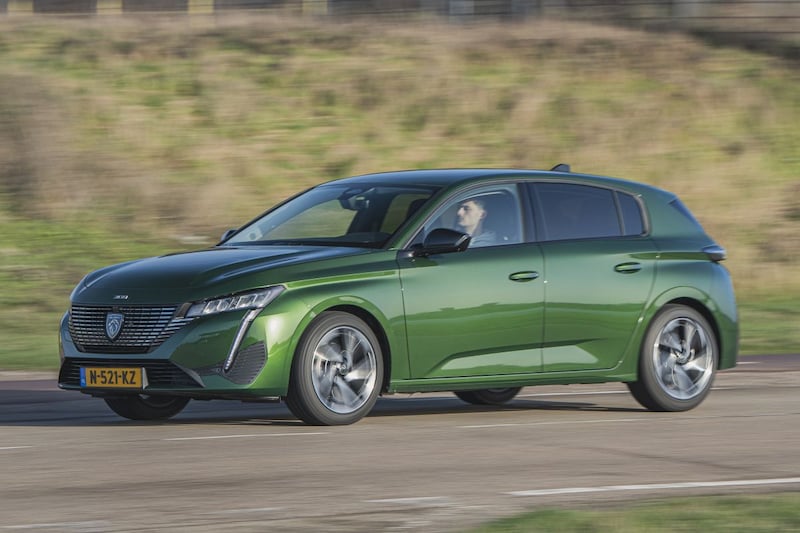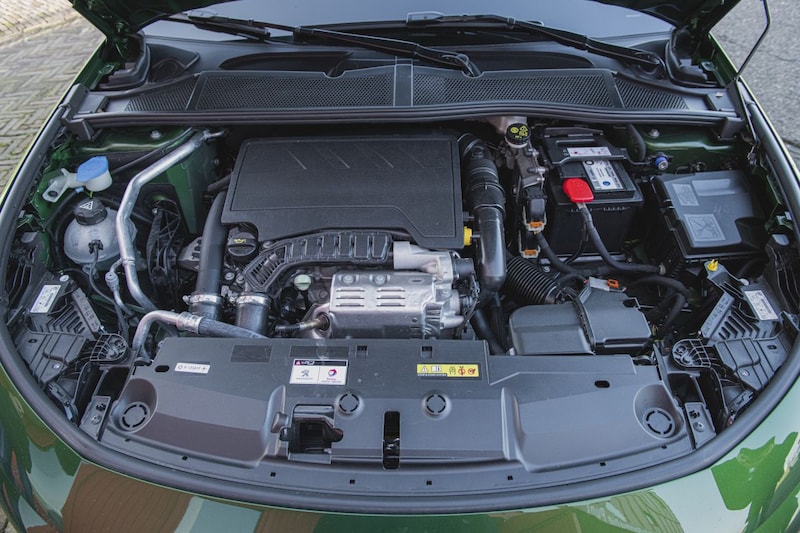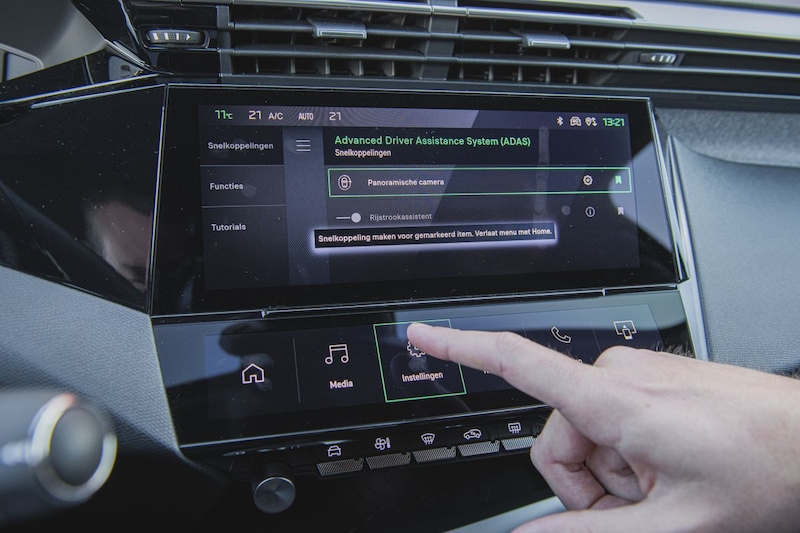Everything about the new Peugeot 308


The almost aggressive, yet unique appearance of the new Peugeot 308 is met everywhere. But that doesn’t make the car a test winner yet. Whether Peugeot has succeeded in improving the 308 in other areas as well, he – equipped with a 130 hp three-cylinder PureTech petrol engine – may demonstrate in this test.
What is striking about the Peugeot 308?
First and foremost: the expressive design. The new 308 is drawn in the style that we know from the 208 and 508, among others, which may work best on this medium scale. The 308 is lower and tighter than its direct predecessor (2014-2021). The front is remarkably aggressive. The characteristic LED ‘tusks’ are assisted by headlight units that in the GT version look even flatter and meaner than on our test car, which is designed as a relatively modest Allure Pack Business. The introduction color ‘Vert Olivine’ may also be there and is the only free option according to good Peugeot use. So if you want something more boring, you have to pay extra. The 308 is the first Peugeot with the renewed brand logo, a coat of arms that is somewhat reminiscent of that of Ferrari and is also applied to the front fenders of the 308 GT.
What catches the eye on board the 308?
For the interior of the 308, Peugeot sticks to its i-Cockpit concept, with a small steering wheel that is not directly in front of, but below the information screen. That works fine in our case, but is not unusual for nothing. The chosen style in the interior is recognizable, but just like on the outside, there is also a lot of new. Certainly in comparison with the previous generation, but also next to the existing Peugeot products, the interior of the new 308 looks sleeker and more modern. The eye-catcher is the double screen in the middle. The lower screen is described by Peugeot as ‘i-Toggles’ and offers a row of shortcuts that can be filled in at will.
Also in the main screen a lot can be arranged as desired, which works very nicely. The infotainment environment is completely new and will be introduced in all Peugeot passenger cars in the coming years. The flag is allowed for that, because the latest system looks much more modern and also works considerably more pleasantly. The menu structure is more logical, there are new, modern functions and the response speed has been improved, although there is still room for improvement in that area. This also applies to the layout here and there. The buttons on the steering wheel are now more logically clustered, the digital instruments are easier to operate and even the wiper lever is easier to understand for anyone who is not used to Peugeot. Very nice!
How does the Peugeot 308 perform as a spacious, comfortable family car?
The Peugeot 308 has a pleasantly light, but not particularly communicative control. At the same time, the car has a comfortably tuned chassis. With the five-door 308 Saloon (hatchback), the front and rear axles are 5.7 centimeters closer to each other than in the station wagon, the 308 SW. The sloping roofline gives you a few centimeters of headroom on the three-person rear seat. The large doors, large windows and light headlining create an airy atmosphere. There is no shortage of seating space, although it is inconvenient in the back that the backrest of the front seats is exactly at the height of the knees which recedes, which takes a big bite out of the knee room.
The regular hatchback has a load volume of 412 liters and if you fold down the rear seats, a load space of 1323 liters is created (308 SW: 608 to 1634 liters). If it is not possible to take all the luggage in the trunk, a trailer of 1200 (PureTech with EAT8 automatic transmission) to 1600 kilograms (BlueHDi 130) can be attached to the possible towbar, depending on the engine.
How does the Peugeot 308 PureTech 130 perform in the test?
We know the 1.2-litre PureTech petrol engine from many other models from Peugeot, Citroën and Opel. In the 308 it comes in two power variants: with 110 or 130 hp. The test car is powered by the most powerful version of the three-cylinder turbo engine, and it works well. It seems to remain a bit more in the background than in other models with the same engine, but has kept its eagerness and suppleness. Partly because of this character, you are well served with 130 hp. In the test car, the engine is linked to a smooth and smooth-shifting six-speed gearbox, and according to our measurements, the 308 reaches 100 km/h in 9.9 seconds. The test consumption of 6.2 l/100 km (1 in 16.2) does not differ much from the manufacturer’s statement (5.6 l/100 km). For a hefty surcharge of 2900 euros, the 308 PureTech 130 can be equipped with an eight-speed automatic transmission.
Peugeot also has two plug-in hybrid variants of the 308 in the program. This version is also available in two power variants, with 180 or 225 hp. Both versions have the same 12.4 kWh battery, which allows fully electric driving over a short distance. The models are supplied as standard with a 3.7 kW on-board charger, an on-board charger with a capacity of 7.4 kW is available at an additional cost. Peugeot specifies an electric range of 60 kilometers for the 308 HYbrid 180, the HYbrid 225 covers a maximum of 59 kilometers on a full battery. The PHEV versions of the 308 have an eight-speed EAT8 automatic transmission as standard.
Finally, there is also a version of the Peugeot 308 with a 130 hp turbo diesel, the 308 BlueHDi 130. Like the PureTech petrol versions, this engine variant can be supplied with an automatic transmission at an additional cost.
What’s standard on the 308?
The new Peugeot 308 is offered in five different trim levels. The Active Pack Business is the basis. This variant rides on wheels with a diameter of 16 inches (Hybrid 180: 17 inches). Climate control with separate temperature control, parking sensors in the rear bumper and a 10-inch central control screen are already installed by Peugeot. The standard safety equipment of the 308 is extensive, and includes active lane assist, autonomous city safety with recognition of pedestrians and cyclists, fatigue warning and traffic sign recognition.
The second trim level in the range, the Allure, includes sports seats, an air quality system, 17-inch alloy, a larger control panel and navigation. If you opt for the Allure Pack Business, you get things like keyless entry, adaptive cruise control, blind spot warning and an alarm for approaching traffic when reversing.
Then there’s GT, which has a more sporty look thanks to 18-inch wheels, full-LED headlights and 3D LED taillights. The seat cover consists of a combination of Alcantara and artificial leather, and is finished with green stitching. In addition, more aluminum is used in the interior, you have a heated sports steering wheel in your hands and the 3D instruments can be set up completely to your own taste.
The most complete version is the GT Pack Business. This version also has an extensive audio system from Focal, a 360-degree camera, Lane Positioning Assist (which maintains the position of the car between the lines on the road) and an electrically adjustable driver’s seat with massage function, which is certified by the German AGR , an association that is committed to limiting back pain.
What are the 308’s main competitors?
The Peugeot 308 operates in the so-called C-segment. This segment used to be popularly known as the ‘Golf class’ – and with that we immediately mentioned one of the main competitors of the 308: the Volkswagen Golf. As usual, models such as the Ford Focus, the Opel Astra and the Toyota Corolla are also very popular in this market segment. The Citroën C4 comes from France, which shares several engines with the 308. Compatriot Renault has now converted the Megane into a fully electric car, and can therefore no longer be considered a competitor for the Peugeot 308.
The choice of AutoWeek test coordinator Marco Gorter
The base engine with 110 hp seems a bit sparse for the new 308, but the 130 hp variant performs well. Since Peugeot uses reasonable prices for individual options, an Allure is actually enough. This can then be supplemented with the desired options, so that you do not pay too much for a version that also contains things that are superfluous.
.
– Thanks for information from Autoweek.nl




